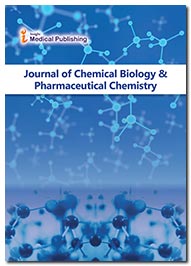ISSN : 2634-7814
Journal of Chemical Biology & Pharmaceutical Chemistry
Poly(sugar acids): Novel acidic polysaccharide poly[3-(3,4-dihydroxyphenyl)glyceric acid] from medicinal plants of Boraginaceae family, its synthetic analogues and their potential therapeutic efficacy
Abstract
The main chemical constit¬uent of high molecular (>1000 kDa) water-soluble preparations from medicinal plants of Symphytum asperum, S.caucasicum, S.officinale, S.grandiflorum, Anchusa italica, Cynoglossum officinale and Borago officinalis (Boraginaceae) according to data of liquid-state 1H, 13C NMR, 2D 1H/13C HSQC, 2D DOSY and solid-state 13C NMR spectra was found to be poly[oxy-1- carboxy-2-(3,4- dihydroxyphenyl)-ethylene] or poly[3-(3,4-dihydroxyphenyl)glyceric acid] (PDPGA). The polyoxyethylene chain is the backbone of this polymer molecule and 3,4-dihydroxyphenyl and carboxyl groups are regular substituents at two carbon atoms in the chain. The repeating unit of this regular polymer is 3-(3,4- dihydroxyphenyl)glyceric acid residue. PDPGA as a 3,4-dihydroxyphenyl derivative of poly(2,3-glyceric acid ether) relates to a class of acidic polysaccharides [poly (sugar acids)] as well. Its basic monomeric moiety glyceric acid is oxidative form of aldotriose glyceraldehyde. Hyaluronidase (Hyal-1) degrades high molecular mass of hyaluronic acid into smaller fragments which have pro-inflammatory effects. PDPGA possesses the ability to inhibit the enzymatic activity of Hyal-1 completely.
Open Access Journals
- Aquaculture & Veterinary Science
- Chemistry & Chemical Sciences
- Clinical Sciences
- Engineering
- General Science
- Genetics & Molecular Biology
- Health Care & Nursing
- Immunology & Microbiology
- Materials Science
- Mathematics & Physics
- Medical Sciences
- Neurology & Psychiatry
- Oncology & Cancer Science
- Pharmaceutical Sciences
